-

-
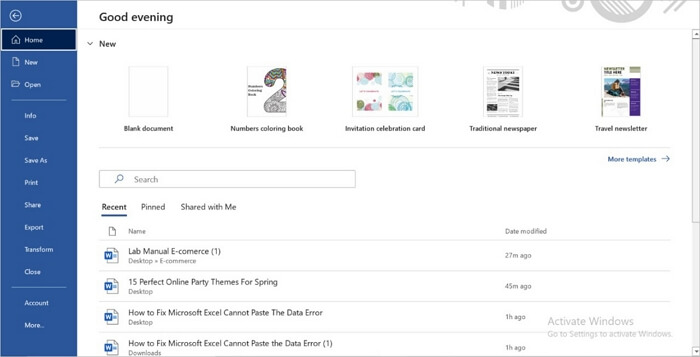 How to Fix Microsoft Office Cannot Open This File Because Some Parts Are Missing or Invalid
How to Fix Microsoft Office Cannot Open This File Because Some Parts Are Missing or Invalid January 23,2025
January 23,2025 6 min read
6 min read -

-

-

-
 How to Recover Permanently Deleted Photos from Gallery Without Backup
How to Recover Permanently Deleted Photos from Gallery Without Backup January 23,2025
January 23,2025 6 min read
6 min read -
 Outlook PST Path: Where Is Outlook PST Files Store on Windows 11/10/8.1/8/7/XP/Vista
Outlook PST Path: Where Is Outlook PST Files Store on Windows 11/10/8.1/8/7/XP/Vista January 23,2025
January 23,2025 6 min read
6 min read -

-
 Fix Blank Word Document: Word Opens But Does Not Display Document [5 Ways]
Fix Blank Word Document: Word Opens But Does Not Display Document [5 Ways] January 16,2025
January 16,2025 6 min read
6 min read -

Page Table of Contents
My Outlook Subfolders are Missing
How to Recover Missing Outlook Subfolders
Where to Find My Outlook Subfolders
Conclusion
Outlook Subfolders Missing FAQs
PAGE CONTENT:
"My Outlook has been having a problem recently and is not showing subfolders correctly. How do I get the missing Outlook subfolders back?"
This Outlook subfolders missing error can occur for multiple reasons, such as a corrupted user profile, conflicts with third-party software, damaged OST, and faulty settings. Worry no more! Our detailed guide will help users deal with this"Outlook Subfolder Missing" issue with practical solutions. Without further ado, let's get started!
My Outlook Subfolders are Missing
Corporate and commercial email sectors are incomplete without the Microsoft Outlook email management functionalities. Outlook offers the top-notch feature of grouping mailboxes and receiving certain emails in specific subfolders. However, multiple users have reported the"Outlook folder Missing" error. If there is no option to navigate to the subfolders in the left pane, the situation has already become problematic for you.
Before we discuss the solution to this error, let's find out the common causes of the"Outlook Subfolder Missin" issue.
- Accidental Deletion: One possible reason for subfolders missing in your Outlook is accidental deletion. You might have moved or deleted the subfolders. Check the trash folder to find out!
- Corrupted Profile: A corrupted or inactive email or user profile may prevent the sending or receiving of data and can be another possible cause of missing Outlook subfolders.
- Network Connection: A poor or disabled internet connection will cause trouble exchanging data with the Outlook servers, which is why you are unable to view subfolders in Outlook Client in Windows.
- Damaged Data File: If the Outlook data file, such as OST or PST, is damaged, you won't be able to see the subfolders in Outlook. The files might get damaged during Outlook crashes, malware infections, system crashes, and more. The damaged data file will no longer be able to synchronize the new emails into the corresponding subfolders.
- Third-Party Software: Sometimes, third-party software might interfere with the functioning of Microsoft Outlook, causing subfolders to disappear.
How to Recover Missing Outlook Subfolders
Are you having trouble with the"Outlook Subfolder Missing" issue and not receiving important emails? Worry no more! We're here to help! If you have lost your essential work emails on Windows 11/10/8/7, we recommend utilizing the EaseUS Data Recovery Wizard software.
No matter if your Windows OS crashes or the Outlook Client gets infected with malware or viruses, you can easily recover emails from lost Outlook subfolders in no time. Moreover, you can recover lost data such as images, videos, and documents from the hard drive, USB drive, and memory cards.
Step 1. Run EaseUS Data Recovery Wizard. Choose "Select Folder" under Specify a location. Browse for the location where you lost the folder and click "OK" to scan.

Step 2. You can search for the target folder or use the Filter feature to find a certain type of files in the folder.

Step 3. You can preview the recovered folder. Then, click "Recover" and choose a new & secure location on your PC or cloud storage to keep the recovered data.

Missing Outlook subfolders will cause inconvenience and affect your daily work routine. Thus, fixing this issue will become a priority for you. We have presented effective solutions to fix the"Outlook Subfolder Missing" problem on your Windows PC.
Where to Find My Outlook Subfolders
There are multiple ways by which you can get your hands on the missing Outlook subfolders on your Windows PC. Let's explore each method in detail.
Method 1. Via Data File Properties
One of the easiest ways to detect all the Outlook folders in the Outlook Windows Client app is through the Data File Properties. You can check access to the Data File Properties for each account and find a list of all the available subfolders. Here's a step-by-step guide on finding missing Outlook subfolders via Data File Properties.
Step 1. Launch Outlook on your PC and right-click on any account's email.
Step 2. Click on "Data File Properties" and then "Folder Size".
Step 3. You can find a list of all sub-folders here.
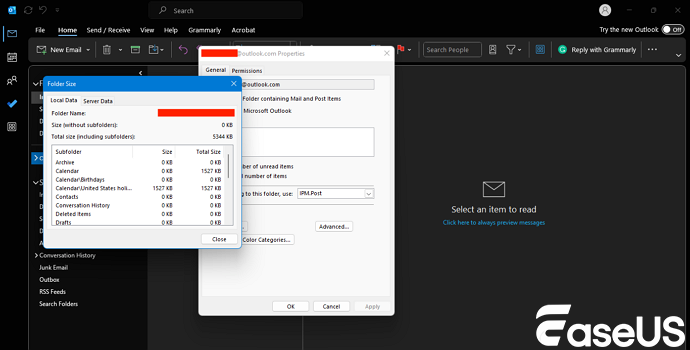
Method 2. Use the Search Function
Do you know you can locate a lost email from a specific folder or all mailboxes collectively? Try the enhanced search functionality! All you need to do is to input the search term and wait for the results. This way, you might find the missing email from the subfolders. Here's how to use the search feature to solve the Outlook Subfolder Missing issue:
Step 1. Launch Outlook on your Windows PC.
Step 2. Simultaneously, press the “Ctrl + Shift + F” buttons to open the "Advanced Find" window. Type any word or phrase you're looking for.
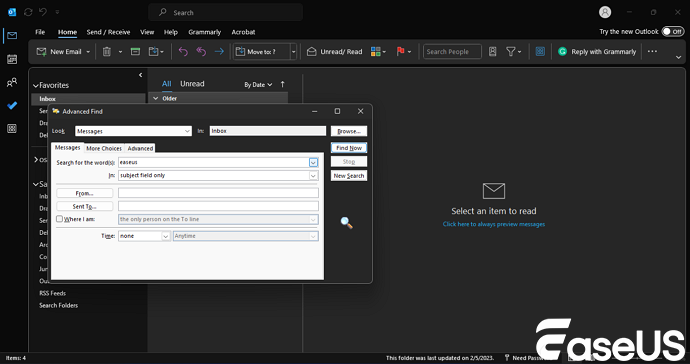
Step 3. If an email is found, click on "Browse" in the right corner, and you'll see the subfolder containing that email.
Method 3. Virtual Basic for Application (VBA) Code
The Virtual Basic for Applications is a programming language designed and crafted by Microsoft. It allows you to search for missing folders in Outlook quickly. Here's a step-by-step guide on how to look for missing Outlook subfolders via Virtual Basic for Application (VBA) Code:
Step 1. Launch the Outlook application on your Windows PC.
Step 2. Navigate to "File > Option" and then "Customize Ribbon."
Step 3. Click on "Developer" and check the tick-box.
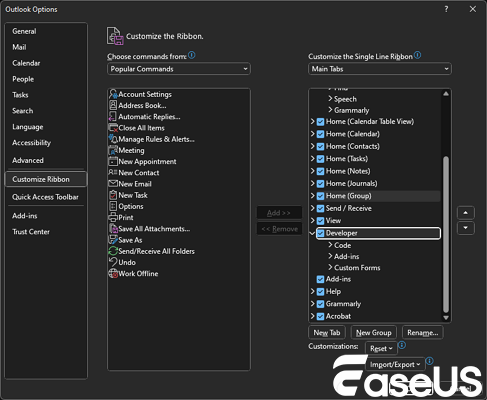
Step 4. Click on "Virtual Basic" from the Developer tab. Expand the "ThisOutlookSession" and enter the VBA code.
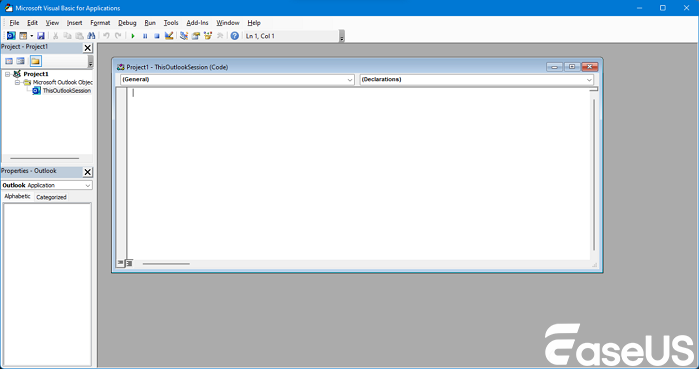
Step 5. Click on Run and then "Run Sub/UserFor" and enter the search term for the missing Outlook subfolder.
Conclusion
Dealing with the"Outlook Subfolder Missing" issue can be annoying, as your important emails will go missing some random day. Finding the root cause is necessary to apply effective remedies to recover the missing subfolders and the emails. You can try the search function, VBA code, or advanced find option to look for the missing subfolders. Additionally, if you wish to recover lost emails, we propose using the EaseUS Data Recovery Wizard. It can help you recover accidentally deleted or lost emails from Outlook.
Outlook Subfolders Missing FAQs
Here are the most asked questions on the "Outlook Subfolder Missing" issue and their answers:
1. How do I show all subfolders in Outlook?
Look for a "down arrow" beside the email address in the left-side pane in the Outlook app. Click on expand and view all the subfolders.
2. How do I restore my subfolders in Outlook?
In Outlook, you can find missing subfolders via search, Advanced Find, and VBA code functionality. You can also try EaseUS Data Recovery Wizard to recover lost or missing emails and subfolders in Outlook.
3. How do I find a missing sub folder in Outlook?
Use the Search box to find a missing email or subfolder, or try "Data File Properties" to look for the missing subfolder.
4. Why did subfolders disappear/miss in Outlook?
Missing Outlook subfolders can be caused by several reasons, including poor network, accidental deletion, damaged data files, or corrupted PST/OST files.
Was this page helpful?
-
Jaden is one of the editors of EaseUS, who focuses on topics concerning PCs and Mac data recovery. Jaden is committed to enhancing professional IT knowledge and writing abilities. She is always keen on new and intelligent products.…

20+
Years of experience

160+
Countries and regions

72 Million+
Downloads

4.8 +
Trustpilot Score
Hot Recovery Topics
Search




